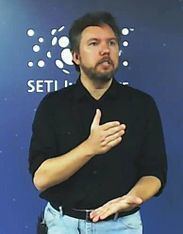Nationality Australian | Occupation Astrophysicist | |
 | ||
Born October 25, 1973 (age 43) ( 1973-10-25 ) | ||
Stephen Kane is an associate professor of astronomy at San Francisco State University who specializes in exoplanetary science. His work covers a broad range of exoplanet detection methods, including the microlensing, transit, radial velocity, and imaging techniques. He is a leading expert on the topic of planetary habitability and the habitable zone of planetary systems. He has published more than 180 scientific papers in refereed journals and has discovered/co-discovered several hundred planets orbiting other stars.
Contents
Education
Kane graduated from Macquarie University with a Bachelors of Science in Physics in 1994. In 1995 Kane received First Class with Honors at the same institution for his work studying a galactic extended source, which he identified as a previously unknown supernova remnant. In 2000 Kane received his Ph.D. from the University of Tasmania with a thesis focusing on gravitational microlensing, the bending of space by gravity which has a variety of astrophysics applications, including the discovery of exoplanets.
Career
During his graduate degree, Kane had the title of research assistant at the Space Telescope Science Institute in 1996. After graduating, Kane joined the University of St. Andrews in 2001 as a postdoctoral research fellow, he collaborated with a team of scientists that discovered the coldest, smallest known exoplanet (OGLE-2005-BLG-390Lb), confirming the hopes that observation of habitable planets was within the reach of technology[7]. Kane and the entire SuperWASP (Super Wide Angle Search for Planets) team was later awarded the Royal Astronomical Society's Group Achievement Award in 2010 for their discovery of 18 exoplanets. In 2005 he returned to the United States to work as a postdoctoral associate at the University of Florida where he discovered some of the hottest known exoplanets of the time. In 2008 Kane became a research scientist at the NASA Exoplanet Science Institute (NExScI) at the California Institute of Technology (Caltech) where he focused his research on exoplanet habitability, the study of properties and conditions favorable to life. While at Caltech he and collaborator Dawn Gelino created the Habitable Zone Gallery, a website dedicated to providing information on exoplanets for both scientists and the general public. Kane joined San Francisco State University in 2013 and was promoted to Associate Professor in 2016. In August 2016, Kane and collaborators released the "Catalog of Kepler Habitable Zone Exoplanet Candidates", identifying numerous Habitable Zone planets discovered by the Kepler mission.
